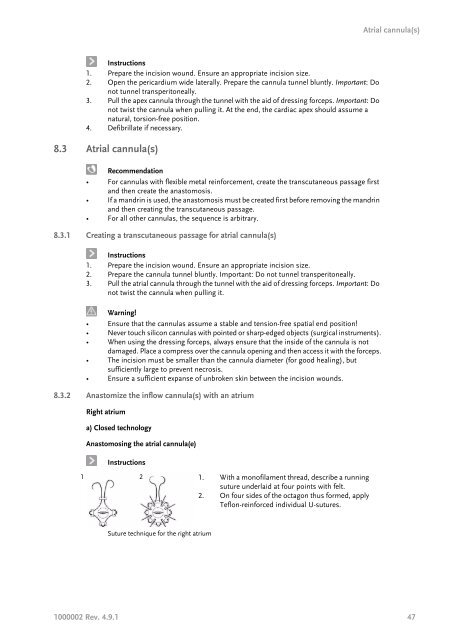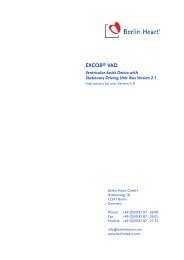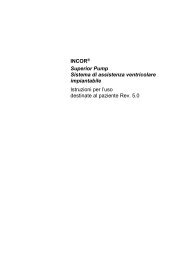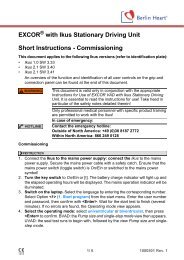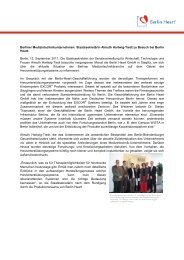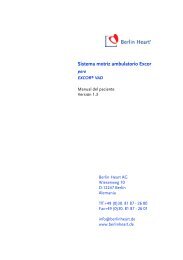Instructions for use: Ikus - Berlin Heart
Instructions for use: Ikus - Berlin Heart
Instructions for use: Ikus - Berlin Heart
Create successful ePaper yourself
Turn your PDF publications into a flip-book with our unique Google optimized e-Paper software.
<strong>Instructions</strong><br />
1. Prepare the incision wound. Ensure an appropriate incision size.<br />
2. Open the pericardium wide laterally. Prepare the cannula tunnel bluntly. Important: Do<br />
not tunnel transperitoneally.<br />
3. Pull the apex cannula through the tunnel with the aid of dressing <strong>for</strong>ceps. Important: Do<br />
not twist the cannula when pulling it. At the end, the cardiac apex should assume a<br />
natural, torsion-free position.<br />
4. Defibrillate if necessary.<br />
8.3 Atrial cannula(s)<br />
Recommendation<br />
• For cannulas with flexible metal rein<strong>for</strong>cement, create the transcutaneous passage first<br />
and then create the anastomosis.<br />
• If a mandrin is <strong>use</strong>d, the anastomosis must be created first be<strong>for</strong>e removing the mandrin<br />
and then creating the transcutaneous passage.<br />
• For all other cannulas, the sequence is arbitrary.<br />
8.3.1 Creating a transcutaneous passage <strong>for</strong> atrial cannula(s)<br />
<strong>Instructions</strong><br />
1. Prepare the incision wound. Ensure an appropriate incision size.<br />
2. Prepare the cannula tunnel bluntly. Important: Do not tunnel transperitoneally.<br />
3. Pull the atrial cannula through the tunnel with the aid of dressing <strong>for</strong>ceps. Important: Do<br />
not twist the cannula when pulling it.<br />
Warning!<br />
• Ensure that the cannulas assume a stable and tension-free spatial end position!<br />
• Never touch silicon cannulas with pointed or sharp-edged objects (surgical instruments).<br />
• When using the dressing <strong>for</strong>ceps, always ensure that the inside of the cannula is not<br />
damaged. Place a compress over the cannula opening and then access it with the <strong>for</strong>ceps.<br />
• The incision must be smaller than the cannula diameter (<strong>for</strong> good healing), but<br />
sufficiently large to prevent necrosis.<br />
• Ensure a sufficient expanse of unbroken skin between the incision wounds.<br />
8.3.2 Anastomize the inflow cannula(s) with an atrium<br />
1<br />
Right atrium<br />
a) Closed technology<br />
Anastomosing the atrial cannula(e)<br />
<strong>Instructions</strong><br />
2 1. With a monofilament thread, describe a running<br />
suture underlaid at four points with felt.<br />
2. On four sides of the octagon thus <strong>for</strong>med, apply<br />
Teflon-rein<strong>for</strong>ced individual U-sutures.<br />
Suture technique <strong>for</strong> the right atrium<br />
Atrial cannula(s)<br />
1000002 Rev. 4.9.1 47


